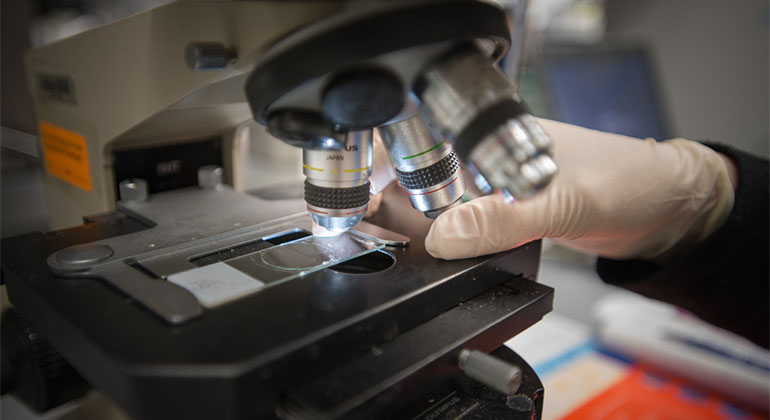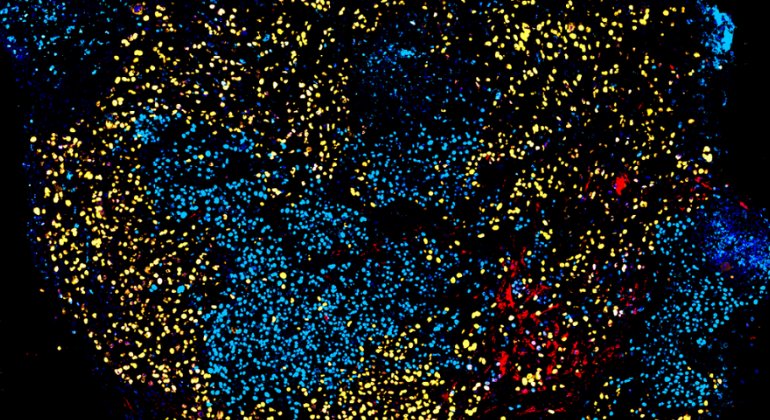Mount Sinai Researchers First to Discover Single Cell Immune Composition of Plaques from Stroke Patients
Findings could lead to better understanding of ischemic cardiovascular events and help the development of new treatments
Atherosclerotic plaque, the fatty buildup in arteries that can lead to heart attack and stroke, contains an abundance of the immune cells known as T-cells, Mount Sinai researchers have shown for the first time.
T-cells are an essential part of the human immune system, helping to protect the body from infection and cancer, but they are suspected of aggravating atherosclerosis. The breakthrough findings, published in the October 7 issue of Nature Medicine, result from a deep single-cell analysis of immune cells in plaque, something that has never been done before in humans. This research can help doctors better understand how the immune system contributes to cardiovascular disease and complications. The study could also lead to development of drugs to target these cells to prevent cardiovascular events.
“This is a first study towards the ultimate goal of building a single-cell immune atlas of human atherosclerosis. By profiling individual cells in blood and atherosclerotic plaques, we found new inflammatory alterations in plaques related to cardiovascular events,” said lead investigator Chiara Giannarelli, MD, PhD, Assistant Professor of Medicine (Cardiology), and Genetics and Genomic Sciences, at the Icahn School of Medicine at Mount Sinai. “We found that T-cells, a cell type known to fight infections and cancer, may have an unanticipated important role in driving atherosclerotic cardiovascular disease. Exploring the diversity of T-cells in human atherosclerosis may lead to new therapeutics in the future.”
Researchers studied 46 patients undergoing carotid artery surgery at The Mount Sinai Hospital (both men and women, with an average age of 72). Forty percent of the patients had recently had a stroke. Investigators analyzed atherosclerotic plaque removed during the surgery and the patients’ blood immune cells. The team used a combination of cutting-edge technologies (called CyTOF, single-cell RNA sequencing, and CITE-seq) to get an in-depth look at the individual protein and gene expression of single cells. They discovered that these patients had an abundance of T-cells along with an increased infiltration of a subset of pro-inflammatory T-cells called CD4+ in patients who had suffered a recent stroke.
Surprisingly, many other subsets of T-cells, including CD8+ T cells, were infiltrating plaques in different forms: some were highly active or inflammatory, others were differentiated and highly specialized to the plaque environment, and some subsets were exhausted, which means they were progressively losing their ability to kill disease cells. Additionally, the exhausted T-cells in these plaques expressed PD-1, a protein that normally prevents T cells from killing other cells including cancer cells.
Normally, CD8+ T cells operate by recognizing and killing cancer cells or cells infected by viruses. More research is needed to identify their specific function and cell targets in atherosclerotic plaques. Ultimately, all these cell subsets and different functions may contribute to increase plaque inflammation in stroke patients, possibly putting these patients at a higher risk of future cardiac events, the researchers said.
“These findings suggest that PD-1 inhibitors, a breakthrough treatment that is used in cancer to turn T-cells against the tumor, may also activate exhausted T-cells in plaque. This could increase plaque inflammation and possibly the risk for cardiovascular events in patients,” said Dr. Giannarelli.
“This study is a perfect example of how single-cell mapping of human disease lesions can transform our understanding of disease pathophysiology,” explained co-author Miriam Merad, MD, PhD, Director of the Precision Immunology Institute, and Director of the Human Immune Monitoring Center at the Icahn School of Medicine at Mount Sinai. “This study has generated a new hypothesis about disease drivers that we hope will lead to novel therapies.”
“This study shows the molecular connections linking blood and cellular make-up of the atherosclerotic plaque within the same individual and the clinical outcome,” said Michelle Olive, Ph.D., Program Officer at the National Heart, Lung, and Blood Institute Division of Cardiovascular Sciences. “This study shows that cutting edge techniques like CyTOF and other single cell technologies are useful in charting the landscape of atherosclerotic plaques.”
J Mocco, MD, MS, Vice Chair of Neurosurgery and Director of the Cerebrovascular Center for the Mount Sinai Health System, and Peter Faries, MD, Chief of Vascular Surgery for the Mount Sinai Health System, made significant contributions to this research.
This study was funded by two grants (K23HL111339 and R03HL135289) from the National Institutes of Health (NIH) and the National Heart, Lung, and Blood Institute (NHLBI).
About the Mount Sinai Health System
Mount Sinai Health System is one of the largest academic medical systems in the New York metro area, with 48,000 employees working across seven hospitals, more than 400 outpatient practices, more than 600 research and clinical labs, a school of nursing, and a leading school of medicine and graduate education. Mount Sinai advances health for all people, everywhere, by taking on the most complex health care challenges of our time—discovering and applying new scientific learning and knowledge; developing safer, more effective treatments; educating the next generation of medical leaders and innovators; and supporting local communities by delivering high-quality care to all who need it.
Through the integration of its hospitals, labs, and schools, Mount Sinai offers comprehensive health care solutions from birth through geriatrics, leveraging innovative approaches such as artificial intelligence and informatics while keeping patients’ medical and emotional needs at the center of all treatment. The Health System includes approximately 9,000 primary and specialty care physicians and 10 free-standing joint-venture centers throughout the five boroughs of New York City, Westchester, Long Island, and Florida. Hospitals within the System are consistently ranked by Newsweek’s® “The World’s Best Smart Hospitals, Best in State Hospitals, World Best Hospitals and Best Specialty Hospitals” and by U.S. News & World Report's® “Best Hospitals” and “Best Children’s Hospitals.” The Mount Sinai Hospital is on the U.S. News & World Report® “Best Hospitals” Honor Roll for 2025-2026.
For more information, visit https://www.mountsinai.org or find Mount Sinai on Facebook, Instagram, LinkedIn, X, and YouTube.

Targeting One Type of Immune Cell With Another Slows Cancer Growth in Preclinical Studies
Oct 25, 2022 View All Press Releases
Novel CRISPR Imaging Technology Reveals Genes Controlling Tumor Immunity
Mar 15, 2022 View All Press ReleasesResearchers Discover Potential Boost to Immunotherapy
Mar 30, 2020 View All Press ReleasesDrug Resistance Signature Discovered in Crohn’s Disease
Aug 29, 2019 View All Press Releases

